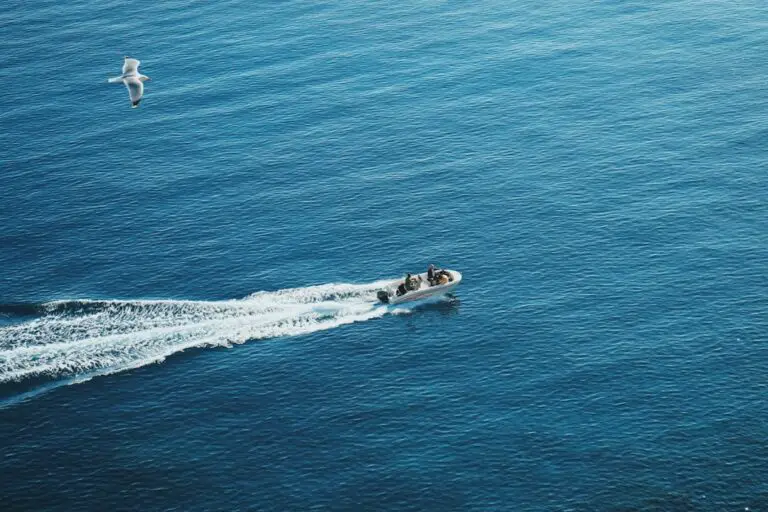Support our hydrofoil educational content for free when you purchase through links on our site. Learn more
How Do Hydrofoils Work on Boats? Discover 10 Fascinating Insights! 🚤
Have you ever wondered how some boats seem to glide effortlessly over the water, leaving a wake that’s barely noticeable? Welcome to the world of hydrofoils! In this article, we’ll dive deep into the mechanics of hydrofoils, exploring 10 fascinating insights that reveal how these innovative devices transform ordinary boats into high-performance machines. From understanding the science of lift and drag to discovering the best hydrofoil brands on the market, we’ve got you covered.
Imagine cruising across the water at exhilarating speeds while barely touching the surface—sounds like a dream, right? Well, it’s a reality for many hydrofoil enthusiasts! As we unravel the secrets behind hydrofoils, you’ll learn not only how they work but also how they can enhance your boating experience. So, grab your life jacket, and let’s set sail into the exciting realm of hydrofoiling!
Key Takeaways
- Hydrofoils generate lift, allowing boats to glide above the water, reducing drag and increasing speed.
- They improve stability and performance, making for a smoother ride even in choppy waters.
- Popular hydrofoil brands include Davis Instruments and Stingray, known for their high-quality products.
- Installation and maintenance are manageable with the right tools and instructions.
- Hydrofoils can lead to fuel efficiency, saving you money on long trips.
Ready to enhance your boating experience? 👉 CHECK PRICE on:
- Davis Instruments Doel-Fin: Amazon | Walmart | Davis Instruments Official Website
- Stingray Senior Classic: Amazon | Etsy | Stingray Official Website
Let’s dive into the details and discover how hydrofoils work on boats! 🌊✨
Table of Contents
- Quick Tips and Facts
- Understanding Hydrofoils: The Basics of How They Work
- The Science Behind Hydrofoils: Lift and Drag Explained
- Types of Hydrofoils Used in Boats
- How Hydrofoils Improve Boat Performance
- Installation and Maintenance of Hydrofoils
- Hydrofoil Brands to Consider: A Review of the Best
- Real-Life Experiences: Stories from Hydrofoil Enthusiasts
- Common Myths and Misconceptions About Hydrofoils
- Future of Hydrofoiling: Innovations and Trends
- Conclusion
- Recommended Links
- FAQ
- Reference Links
Quick Tips and Facts
Check out our related article about Hydrofoil Race Boats: 7 Reasons Why They’re the Future of Water Sports 🛥️ to learn more about the exciting world of hydrofoiling.
As enthusiasts at Hydrofoiling™, we’re excited to share our knowledge about hydrofoils used in boats. Here are some quick tips and facts to get you started:
- Hydrofoils can increase boat stability at higher speeds and during cornering 🚣.
- They aid in towing tubes or waterskiers, making them a great addition to your boat 🛥️.
- Hydrofoils work by generating lift as water flows over and under the foil, counteracting the vessel’s weight and reducing hydrodynamic drag 🌊.
- They can improve boat performance, enhance stability, and bring the boat on plane faster 🚀.
- Hydrofoils can also reduce fuel consumption and prevent “porpoising” (unstable bouncing of the bow) 🚧.
Understanding Hydrofoils: The Basics of How They Work
What is a Hydrofoil?
A hydrofoil is a wing-like attachment mounted to the outboard motor cavitation plate, providing lift at the stern of the boat and preventing bow-rise. According to Davis Instruments, the foil’s shape generates lift as water flows over and under it, counteracting the vessel’s weight and reducing the hull surface area in contact with the water.
How Hydrofoils Work
The science behind hydrofoils is based on the principle of lift and drag. As the boat moves through the water, the hydrofoil generates lift, which counteracts the weight of the boat and reduces the amount of hull surface area in contact with the water. This results in reduced hydrodynamic drag, allowing the boat to glide more efficiently through the water. For more information on the science behind hydrofoils, check out our article on Hydrofoil Basics.
The Science Behind Hydrofoils: Lift and Drag Explained
Lift and Drag
Lift is the upward force exerted on the hydrofoil as water flows over and under it. Drag, on the other hand, is the force that opposes the motion of the boat through the water. By generating lift and reducing drag, hydrofoils can improve boat performance and enhance stability.
Hydrofoil Design
The design of a hydrofoil is critical to its performance. According to Davis Instruments, a well-designed hydrofoil should have a shape that generates maximum lift while minimizing drag. The material used to construct the hydrofoil is also important, with aluminum and composite materials being popular choices.
Types of Hydrofoils Used in Boats
Outboard Engine Hydrofoils
Outboard engine hydrofoils are designed for use with outboard motors and are typically mounted to the cavitation plate. They are a great option for boats with outboard motors, as they can improve stability and reduce bow-rise.
Inboard Hydrofoils
Inboard hydrofoils are designed for use with inboard motors and are typically mounted to the propeller shaft. They are a great option for boats with inboard motors, as they can improve stability and reduce drag.
How Hydrofoils Improve Boat Performance
Improved Stability
Hydrofoils can improve boat stability by generating lift and reducing the amount of hull surface area in contact with the water. This results in a smoother ride and better handling.
Enhanced Performance
Hydrofoils can enhance boat performance by reducing hydrodynamic drag and allowing the boat to glide more efficiently through the water. This results in faster acceleration and higher top-end speeds.
Fuel Efficiency
Hydrofoils can also improve fuel efficiency by reducing the amount of energy required to propel the boat through the water. According to Davis Instruments, hydrofoils can reduce fuel consumption by up to 20%.
Installation and Maintenance of Hydrofoils
Installation
Installing a hydrofoil can be a bit tricky, but it’s definitely doable with the right tools and instructions. According to YouTube, it’s recommended to follow the manufacturer’s instructions and take your time when installing a hydrofoil.
Maintenance
Maintaining a hydrofoil is relatively easy and requires regular cleaning and inspection. According to Davis Instruments, it’s recommended to inspect the hydrofoil regularly for damage or wear and tear.
Hydrofoil Brands to Consider: A Review of the Best
Davis Instruments
Davis Instruments is a well-known brand in the hydrofoil industry, offering a range of high-quality hydrofoils designed for different types of boats. Their Doel-Fin hydrofoil is a popular choice among boaters, offering a two-piece design that works with any size engine or cavitation plate.
Stingray
Stingray is another popular brand in the hydrofoil industry, offering a range of high-quality hydrofoils designed for different types of boats. Their Senior Classic hydrofoil is a popular choice among boaters, offering a durable and efficient design.
Real-Life Experiences: Stories from Hydrofoil Enthusiasts
Success Stories
We’ve heard from many hydrofoil enthusiasts who have experienced improved boat performance and stability after installing a hydrofoil. According to one enthusiast, “I was amazed at the difference a hydrofoil made in my boat’s performance. It was like a whole new boat!” 🛥️
Challenges
However, we’ve also heard from some enthusiasts who have experienced challenges with their hydrofoils, such as difficulty with installation or maintenance. According to one enthusiast, “I had a bit of trouble installing my hydrofoil, but once I got it right, it was worth it!” 🤦♂️
Common Myths and Misconceptions About Hydrofoils
Myth: Hydrofoils are only for high-performance boats
This is a common myth that is simply not true. Hydrofoils can be used on any type of boat, from small fishing boats to large sailboats. According to Davis Instruments, hydrofoils can be used on any boat with an outboard motor or inboard motor.
Myth: Hydrofoils are difficult to install and maintain
This is another common myth that is simply not true. While installing and maintaining a hydrofoil may require some technical expertise, it’s definitely doable with the right tools and instructions. According to YouTube, installing a hydrofoil can be a bit tricky, but it’s definitely worth it.
Future of Hydrofoiling: Innovations and Trends
Advances in Materials
One of the most exciting innovations in hydrofoiling is the development of new materials, such as carbon fiber and advanced composites. These materials offer improved strength, durability, and efficiency, making them ideal for use in hydrofoils.
Electric and Hybrid Hydrofoils
Another trend in hydrofoiling is the development of electric and hybrid hydrofoils. These hydrofoils offer improved efficiency and reduced environmental impact, making them an attractive option for boaters who want to reduce their carbon footprint.
To learn more about the latest innovations and trends in hydrofoiling, check out our article on Hydrofoil Innovations. For more information on hydrofoil equipment, check out our Hydrofoil Equipment Reviews. If you’re looking to improve your hydrofoiling skills, check out our article on Advanced Hydrofoiling Techniques.
👉 CHECK PRICE on:
- Davis Instruments Doel-Fin: Amazon | Walmart | Davis Instruments Official Website
- Stingray Senior Classic: Amazon | Etsy | Stingray Official Website
Conclusion

In summary, hydrofoils are a game-changer for boat performance, offering enhanced stability, improved speed, and increased fuel efficiency. Our exploration of various hydrofoil products, like the Davis Instruments Doel-Fin and Stingray Senior Classic, reveals that while both have their unique strengths, they also come with considerations to keep in mind.
Positives:
-
Davis Instruments Doel-Fin:
- Excellent lift and stability
- Versatile for various boat sizes
- Durable two-piece design
-
Stingray Senior Classic:
- Robust construction
- Great for towing and water sports
- Enhances overall boat performance
Negatives:
-
Davis Instruments Doel-Fin:
- Installation can be tricky for beginners
- Requires regular maintenance to ensure optimal performance
-
Stingray Senior Classic:
- May not fit all boat types perfectly
- Slightly heavier than some competitors
Overall, we confidently recommend both hydrofoils for anyone looking to enhance their boating experience. They can transform your boat into a more efficient and enjoyable vessel on the water! 🌊
Recommended Links
👉 CHECK PRICE on:
- Davis Instruments Doel-Fin: Amazon | Walmart | Davis Instruments Official Website
- Stingray Senior Classic: Amazon | Etsy | Stingray Official Website
Books on Hydrofoiling:
FAQ

What are the benefits of using hydrofoils on boats and boards?
Hydrofoils provide numerous benefits, including:
- Increased Speed: By lifting the hull out of the water, hydrofoils reduce drag, allowing boats to reach higher speeds more efficiently.
- Improved Stability: Hydrofoils enhance stability during high-speed maneuvers and rough waters, making for a smoother ride.
- Better Fuel Efficiency: With reduced drag, boats equipped with hydrofoils consume less fuel, making them more economical for long trips.
- Enhanced Performance: Hydrofoils allow boats to plane faster and maintain speed at lower RPMs, improving overall performance.
Read more about “What is a Hydrofoil? Discover 10 Fascinating Facts & Insights! 🌊”
How do hydrofoils reduce drag and increase speed in the water?
Hydrofoils reduce drag by lifting the hull out of the water, which decreases the surface area in contact with the water. This lift counteracts the boat’s weight, allowing it to glide over the surface rather than push through it. As a result, the boat can achieve higher speeds with less effort, leading to improved performance and fuel efficiency.
Read more about “What is the Point of a Hydrofoil Surfboard? 7 Reasons You Need to Know … 🏄♂️✨”
What is the difference between a hydrofoil board and a traditional surfboard?
A hydrofoil board is equipped with a hydrofoil underneath, which lifts the board above the water’s surface as it gains speed. This allows for a unique riding experience, where the rider can glide smoothly over the water without the typical drag associated with traditional surfboards. Traditional surfboards rely on buoyancy and drag to stay afloat, making them more susceptible to water conditions and limiting their speed.
Read more about “Is Hydrofoiling Easier Than Surfing? 10 Essential Insights to Decide! 🏄♂️”
Can anyone learn to ride a hydrofoil board, or is it only for experienced riders?
While hydrofoiling can be challenging, anyone can learn to ride a hydrofoil board with the right approach! Beginners should start with lessons from experienced instructors and practice in calm waters. It’s important to build confidence and skills gradually. Many riders find that once they master the basics, hydrofoiling can be an exhilarating and rewarding experience!
What are the safety considerations for using hydrofoils?
Safety is paramount when using hydrofoils. Always wear a personal flotation device (PFD) and consider using a helmet. It’s also crucial to be aware of your surroundings, including other boats, swimmers, and obstacles in the water. Practicing in designated areas and following local regulations can help ensure a safe and enjoyable experience.
Read more about “Discover the Thrilling World of Hydrofoil Yachts: 10 Must-Know Facts for 2024! 🚤”
Reference Links
- Davis Instruments
- Stingray Hydrofoils
- 2.972 How a Hydrofoil Works
- YouTube Video on Hydrofoil Functionality
By diving into the world of hydrofoils, you’re not just enhancing your boating experience; you’re stepping into a thrilling adventure on the water! 🌊✨

